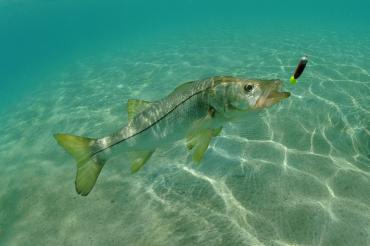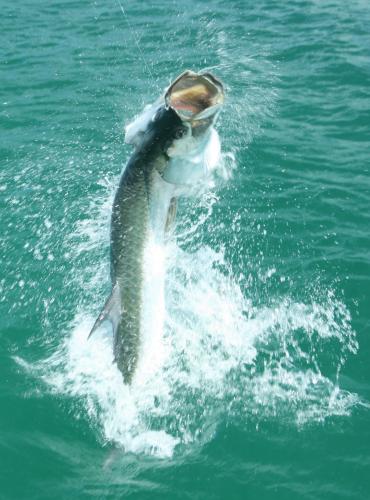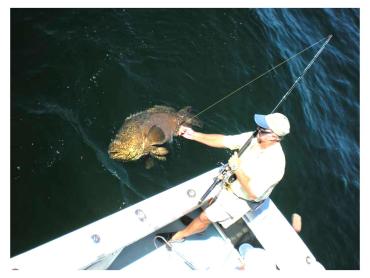Our Expert
We're happy to present this post from Alycia Downs, a fifth-generation native Southwest Floridian who has spent her life on the water and who has served as the Chief Program & Development Officer for Captains for Clean Water since 2018.
Top Fishing Spots in Punta Gorda
Charlotte Harbor, the second-largest natural estuary in Florida, is one of the premier fishing destinations in the state. Along with Boca Grande Pass, the area is known as the "Tarpon Fishing Capital of the World."
Anglers from all over the world visit to test their mettle against over 275 fishable species—for the excitement and challenge, for bragging rights, sometimes for prize money, and sometimes to catch dinner!
For those new to the waters of Punta Gorda, the best spots depend on what you want to catch and when you're visiting. Charlotte Harbor, Boca Grande Pass and Pine Island Sound are bucket-list areas.
For those who want a deep-sea fishing experience, the Gulf awaits! This is an all-day trip and ideal for those looking to hook a Snapper, Grouper, and Amberjack.
When it comes to freshwater fishing, Webb Lake and the Marl Ponds Fish Management Area earn top marks. The top freshwater species to target are Florida Freshwater Bass, Bluegill Bream, Catfish and Tilapia.
It’s easy to hire a fishing charter in Punta Gorda. They offer local knowledge and seasonal expertise and are familiar with Florida fish species, all of which will enhance your fishing trip. Look for a local guide who has been certified by Florida Sea Grant as a "Florida Friendly Fishing Guide." These guides have completed a rigorous certification process proving their commitment to preserving the future of Florida’s fisheries through sustainable boating and fishing techniques.
When is the best time of year to go fishing in Charlotte Harbor?
The best time to fish is when you have PTO days. The weather is good year-round, and fish in Florida are always biting.
Depending on the migration of certain species and the bag limits, each angler will want to tailor their visit to their desired catch. Keep in mind, some fish are strictly catch and release, like the Tarpon. For the most up-to-date information on the fishing regulations, visit the Florida Fish and Wildlife Conservation Commission at MyFWC.com.
For more information about fish licenses and permits, including purchasing online for out-of-state residents, head to myfwc.com.
Top Five Saltwater Fish Species in Punta Gorda
While there are many sport fish in the area, we're spotlighting the top six saltwater superstars that live on many anglers' bucket lists. One of these fish is so massive it can break your equipment, while another demands split-second timing during spawning season.
The Common Snook
Back to Top of ListThis stealthy “ambush feeder” is one of the most targeted game fish in Florida. They're easily identified by their distinctive body shape, protruding lower jaw, and a lateral black line running along their body. Snook can grow up to 45 inches and are known for spirited fights with hard, fast runs and airborne head shakes.
Season / Location
Target snook from March through April, when massive schools spawn in the warm waters of the passes and along the beaches, resulting in many hungry and aggressive fish. Snook are catch-and-release only during the closed season in summer to allow the spawning population to recover. They move inshore in the fall and can be targeted from October through November around mangroves, canals, and other structures.
Tips and Techniques
Low-light fishing, at dawn and dusk, will increase your chances of hooking a snook.
Limits
The bag limit is one fish per person, and the slot limit size is 28–33 inches total length. Please note: limits are subject to change. If you're heading out on your own, check the most up-to-date information on MyFWC.com. If you're with a charter captain, they will have the current regulations.
The Tarpon
Back to Top of ListThe fabled “Silver King” is a catch-and-release-only game fish known for its impressive acrobatics and monstrous size. These prehistoric fish can reach up to 8 feet in length and weigh as much as 280 pounds.
Season / Location
The best time to target tarpon is from April through June during their migration. Post-spawn tarpon can be targeted from July through October. Juveniles are commonly found in the brackish waters and dark canals of the Myakka and Peace Rivers.
Limits
Tarpon are always catch-and-release only, with one exception: the pursuit of an International Game Fish Association (IGFA) world record. A tarpon tag must be pre-purchased in order to keep a tarpon and submit it for world record consideration and only one tag per person/per year/per boat is issued.
Special Considerations
There are strict guidelines when it comes to removing a tarpon from the water: a fish over 40 inches must never be lifted out of the water—it is both illegal and harmful to the fish. Tarpon under 40 inches can be lifted for a very short time, as for a photo or measuring, but their belly must be supported with wet hands.
The Cobia
Back to Top of ListLooks and Fight
The cobia is a hard-fighting fish that commonly weighs 20–50 pounds but can reach up to 100 pounds or more. They have a shark-like appearance with a long, flat, broad head, sharp spines on their first dorsal fin, and a dark lateral stripe running from gill to tail.
Season / Location
Cobia are a migratory species that pass through Southwest Florida in the winter and migrate north in the summer. They are often accompanied by rays or other large fish and tend to hang nearshore around buoys, markers, bridges, shallow reefs, and wrecks.
Limits
The minimum size limit is 36” fork length (measured from the tip of the jaw or snout with closed mouth to the center of the fork in the tail) with a daily bag limit of 1 fish per person/per day or 2 fish per vessel/per day, whichever is less.
The Grouper
Back to Top of ListVarious grouper species can be found in Charlotte Harbor and nearby waters, including gag, red, black, mangrove (also known as gray snapper), and, of course, the infamous giant of the family, the goliath grouper.
Groupers are ambush predators and are, overall, stout with distinctively large mouths and thick, long bodies. Their subtle colors are in almost camouflage-like patterns. This is a very strong fish but with limited stamina. Fighting style varies between types of grouper, but generally they give a short but powerful fight characterized by heavy head shakes and by becoming dead weight. No matter their size, groupers pack a serious punch and provide a real workout for anglers.
Season / Location
Typically caught using bottom-fishing techniques or spearfishing, these heavyweights are often found hunkered down on reefs, wrecks, under bridges, and around any rocky structures. Generally, grouper are best targeted from April to November, with peak activity during warmer months. Open seasons vary significantly by species and location—your charter captain will know, but if you’re heading out on your own, check MyFWC.com.
Limits
Subject to change, but current grouper limits are:
- Goliath: harvest is prohibited
- Gag: 2 per person with a minimum 24” size
- Black: 4 per person with a 24” limit
- Red: 2 per person at a 20” minimum
- Mangrove, aka gray snapper: 5 per person/10 per vessel at a size of 10”
The Spotted Seatrout
Back to Top of ListLooks and Fight
Also known as the speckled trout, this is a favorite among anglers nationwide and suits all skill levels from beginner to expert. Seatrout are characterized by a downturned mouth and pair of large canine teeth on upper jaw. The back is dark grey or green with several black spots and the belly is silver or white. Averages 1–2 pounds but can grow up to 17 pounds and up to 39 inches long.
Season / Location
During the warm months, seatrout are found inshore, mostly in shallow grass flats. As temperatures drop, they move into deeper waters. Seatrout often thrive after cold fronts, making them a staple species for winter fishing.
Limits
Limited to 3 fish per person/per day at no less than 15" and no greater than 19" in length.
The Red Drum (Redfish)
Back to Top of List Looks and Fight
Looks and Fight
One of the most prevalent sport fish in all of Florida, the redfish is characterized by its deep bronze to light gold coloring and the conspicuous black spot—or spots—on its tail. Their stocky shoulders and downward-facing mouth make the redfish a solid fighter known for bullish runs.
Season / Location
Peak redfish season is October through December and March through May. Their spawning season is August through December, offshore.
Redfish are commonly found around rock jetties, mangrove shorelines, and cruising grass flats. In the fall and spring, they often school up in bays and on flats.
Limits
1 per person/per day with a maximum of 4 per vessel per day. Slot limit is no smaller than 18" and no larger than 27" total length.
Ready, Set, Fish!
With an eye always toward conservation, we're happy to recommend our very own Florida Friendly Fishing Guide captains who are committed to sustainable fishing and boating practices in order to preserve the future of our fishery.
No matter which charter captain you choose, though, you’re automatically covered and won't have to purchase a license. If you're heading out on your own, visit myfwc.com to get a fishing license and get informed on Florida’s regulations for each species.
Also, check out our handy Fishing Reports for information about which species can be targeted during each month.







